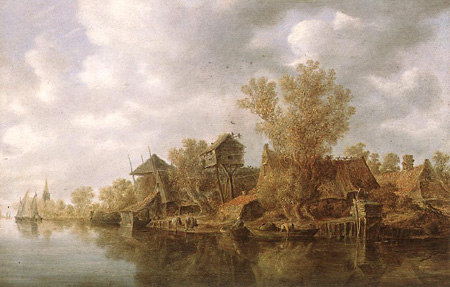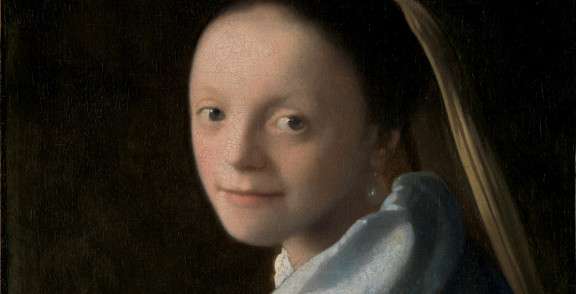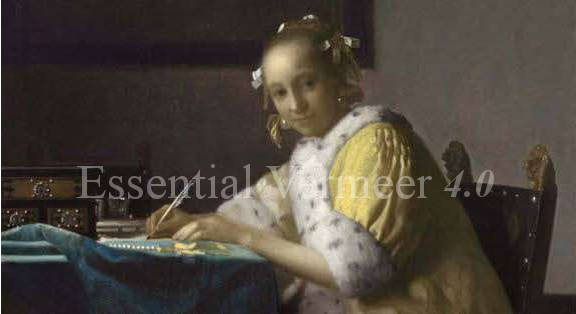Village at the River
Jan van Goyen1636
Oil on panel, 39.5 x 60 cm.
Alte Pinakothek, Munich

VAN GOYEN, Jan Josephsz.
Leiden 1596–The Hague 1656
Van Goyen's exquisite and fragile style of painting seascapes, river scenes and landscapes led him to be neglected for 200 years after his death, when a more finished type of picture was preferred. Now the situation is reversed: his open skies and lightly suggested trees and buildings are much prized by connoisseurs.
Van Goyen was born in Leiden and spent his early life there, being apprenticed, as was the young Rembrandt a few years later, to Isaac Nicolai van Sweenburgh. About 1616 he spent a crucial year in nearby Haarlem as a pupil of Esaias van der Velde, and this painter's influence was to remain for the rest of van Goyen's life. He then spent the 1620s back in Leiden and in the early 1630S moved to The Hague. He must, however, have revisited Haarlem, as in 1634 he was recorded in the house of Isaac van Ruisdael, who was the brother Salomon van Ruisdael. He sprnt the rest of his life in The Hague and in 1651 received the important commission to paint a panoramic view of the town which was to be placed in the Burgomaster's room in the Town Hall.
Van Goyen's development as an artist is relatively easy to follow, as a sufficiently large number of his pictures are signed and dated. His very earliest pictures are highly colored and very dose in style to those of Esaias van de Velde. He soon abandoned this manner and in the 1620s started to paint a large number of river scenes in cool colours, exactly like his Haarlem contemporaries Salomon van Ruisdael and Pieter de Molijn. In the late 1630s and 1640s his style changed again and approached a complete monochrome. The colour of the wooden panel or the prepared ground dominates the picture and each element is lightly sketched in, allowing the ground to show through.Though spending most of his mature career living permanently in The Hague, painting in a manner typical of Haarlem, he seems to have been an insatiable traveler. A large number of his landscapes have identifiable topographical elements in them, and most Dutch towns and even villages appear in one or more of his pictures. They are rarely topographically accurate in the strict sense of the word, but the individual buildings are usually easy to recognize. The town which he painted most frequently was Dordrecht, where the cathedral can be seen at a distance from over the water.
Van Goyen was enormously prolific. Clearly his small, quickly executed pictures did not take long to paint, as minute detail was suggested rather than painstakingly filled in. Nevertheless his rapid brushwork was never facile. All his authentic pictures have a marvelous feeling for nature. They are rarely anecdotal. His human figures are usually adjuncts to the composition to give atmosphere. Van Goyen had a large number of now largely anonymous imitators and followers. All over the western world, where there are collections of Dutch pictures, there are slight and inferior landscapes painted in imitation of van Goyen.
from:
Christopher Wright, The Dutch Painters: 100 Seventeenth Century Masters, London, 1978
- Willem van Aelst (2)
- Balthasar van der Ast (6)
- Hendrick Avercamp (3)
- Dirck van Baburen (7)
- Jacob Adriaenz. Backer (3)
- David Bailly
- Ludolf Bakhuysen
- Bartholomeus van Bassen
- Cornelis Bega
- Gerrit Berckheyde (2)
- Gillis Gillisz de Bergh
- Jan van Bijlert (7)
- Jan de Bisschop (2)
- Abraham Bloemaert (4)
- Pieter De Bloot
- Ferdinand Bol (3)
- Hans Bollinger
- Paulus Bor (2)
- Ambrosio Bosschaert (7)
- Jan Both
- Leonaert Bramer (4)
- Salomon de Bray (2)
- Quiringh van Brekelenkam (4)
- Jan Gerritszoon van Bronchorst (2)
- Adriaen Brouwer (5)
- Hendrick ter Brugghen (6)
- Hendrick van der Burch (5)
- Willem Buytewech (6)
- Abraham van Calraet (2)
- Jacob van Campen
- Jan van de Cappelle(3)
- Pieter Claesz (4)
- Pieter Codde (6)
- Adriaen Coorte (9)
- Josse van Craesbeeck (2)
- Aelbert Cuyp (6)
- Philip van Dijk
- Gerrit Dou (10)
- Willem Drost (2)
- Hendrick Dubbels
- Jacob Duck (4)
- Karel Dujardin (3)
- Willem Duyster (5)
- Gerbrand van den Eeckhout
- Pieter Jansens Elinga
- Cesar van Everdingen (5)
- Allaert van Everdingen
- Carel Fabritius (5)
- Goveart Flinck
- Frans Francken the Younger
- Aert de Gelder
- Cornelis Gijsbrechts
- Jan van Goyen (6)
- Frans Hals (3)
- Dirck Hals (5)
- Jan Davidsz. Heem (6)
- Maerten van Heemskerck
- Bartholomeus van der Helst (4)
- Jan van der Heyden (8)
- Meyndert Hobbema (3)
- Gerard van Honthorst (8)
- Pieter de Hooch (12)
- Van Hoogstraten (9)
- Gerard Houckgeest (4)
- Jan van Huysum (3)
- Willem Kalf (4)
- Jan van Kessel
- Philip Koninck (2)
- Gérard de Lairesse (5)
- Pieter Lastman
- Judith Jansdochter Leyster (5)
- Jan Lievens (4)
- Jacob van Loo (7)
- Nicolaes Maes (9)
- Cornelis de Man (5)
- Gabriel Metsu (12)
- Michiel Janz. van Mierevelt (3)
- Frans van Mieris (8)
- Jan Miense Molenaer (5)
- Pieter Molijn (2)
- Paulus Moreelse (2)
- Pieter Mulier
- Michiel van Musscher (5)
- Aert van der Neer (3)
- Eglon van der Neer (3)
- Caspar Netscher (5)
- Jacob Ochervelt (8)
- Jacob van Oost (2)
- Adriaen van Ostade (5)
- Antonie Palamedesz (6)
- Adam Pijnacker (5)
- Egbert van der Poel (2)
- Jan Porcellis (4)
- Pieter Symonz. Potter
- Paulus Potter (7)
- Pieter Jansz. Quast (2)
- Rembrandt van Rijn (complete oeuvre)
- Jacob van Ruisdael (8)
- Solomon van Ruisdael (7)
- Rachel Ruysch (2)
- Pieter Saenredam (3)
- Godfried Schalcken (6)
- Hercules Segers (2)
- Hendrick Sorg (4)
- Jan Steen (8)
- Harmen Steenwyck (3)
- Matthias Stom (2)
- Michael Sweerts (6)
- David Teniers the Younger
- Gerrit ter Borch (15)
- Willem van de Velde (7)
- Jacob van Velsen
- Johannes Verkolje (2)
- Jan Cornelisz Verspronck (4)
- Abraham de Verwer
- Simon de Vlieger
- Hendrick van Vliet (2)
- Daniel Vosmaer (4)
- Jacobus Vrel (8)
- Jacob van Walscapelle (2)
- Jan Baptist Weenix (2)
- Jan Wijnants (3)
- Emanuel de Witte (6)
- Philips Wouwermans (2)



